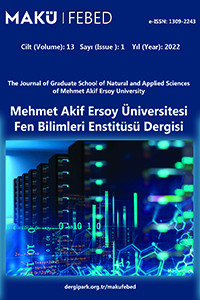Helix lucorum’un Tükrük Bezinin Histokimyasal Yapısı
Five cell types had different size, number and morphological features were identified in salivary glands of Helix lucorum in the both periods and they were called as Type 1, 2, 3, 4 and 5. As a result of the histochemical applications, it was detected that the cells of salivary glands in the hibernation period showed stronger reaction than in the active period. Aganist not all histochemical stainings in the vakuoles of the cell called Type 1, reaction was not observed. While the neutral glycoconjugate were found in all cell types in active period, they were observed only in the cell type 1 in hibernation period. It was detected that unlike other cells the sulphated acidic glycoconjugate was decreased in type 1 and 2 in hibernation period. Also it was determined that size of the cells was decreased and number of the cells was increased in hibernation period.
Anahtar Kelimeler:
Helix lucorum, salivary gland, histochemistry, mucus.
The histochemical structure of salivary gland of Helix lucorum
Five cell types had different size, number and morphological features were identified in salivary glands of Helix lucorum in the both periods and they were called as Type 1, 2, 3, 4 and 5. As a result of the histochemical applications, it was detected that the cells of salivary glands in the hibernation period showed stronger reaction than in the active period. Aganist not all histochemical stainings in the vakuoles of the cell called Type 1, reaction was not observed. While the neutral glycoconjugate were found in all cell types in active period, they were observed only in the cell type 1 in hibernation period. It was detected that unlike other cells the sulphated acidic glycoconjugate was decreased in type 1 and 2 in hibernation period. Also it was determined that size of the cells was decreased and number of the cells was increased in hibernation period.
Keywords:
Helix lucorum, salivary gland, histochemistry, mucus.,
___
- Allen, A. & Flemstrom, G. (2005). Gastroduodenal mucus bicarbonate barrier: Protection against acid and pepsin. Journal Physiology Cell Physiology. 288, C1-19.
- Beltz, B. & Gelperin, A. (1979). An ultrastructural analysis of the salivary system of the terrestrial mollusc Limax maximus. Tissue and Cell. 11 (1), 31-50.
- Bransil, R., Stanley E. & Tsukahara, M. (1995). Mucin biophysics. Annual Review Physiology. 57, 635–657.
- Culling, C. F. A., Reid, P. E. & Dunn, W. L. (1976). A new histochemical method for the identification and visualization of both side chain acylated and non-acylated sialic acids. The Journal of Histochemistry and Cytochemistry. 24, 1225-1230.
- Dimitriadis, V.K., (2008). Structure and function of the digestive system in stylommophora. In, Barker GM (Ed): The biology of terrestiral mollusc, CAB Inter, North America, 238-244,.
- Fretter, V. & Hian, K. B. (1979). The spelization of the Aplysiid gut. Malacologia, 18, 7-11.
- House, C. R., (1980). Phsiology of invertebrate salivary glands. Biol Rev, 55, 417-473.
- Gomari, G., (1952). Gomari’s Aldehyde Fuchsin Stain. In: Cellular Pathology Technique. Culling, C. F. A., Allison R. T. & Barr, W. T. (Eds.) pp. 238, Butterworths, London.
- Katsuyama, T., Ota, H., Ishii, K., Nakayama, J., Kanai, M., Akamatsu, T. & Sugiyama, A. (1991). Histochemical characterization of gastric mucin-secreting cells and the surface mucous gel layer. In: Gastrointestinal Function: Regulation and Disturbances. Kasuya, T., Tsuchiya, M., Nagao, F., Matsuo, Y. (Eds.). Excerpta Medica.145-165., Amsterdam.
- Lev, R. & Spicer, S. S. (1964). Specific staining of sulphate groups with alcian blue at low pH. The Journal of Histochemistry and Cytochemistry. 12, 309-309.
- Lobo-da-Cunha, A. (2001). Ultrastructural and histochemical study of the salivary glands of Aplysia depilans (Mollusca, Opisthobranchia). Acta Zoologica. 82, 201-212.
- Lobo-da-Cunha, A.& Calado, G. (2008). Histology and ultrastructure of the salivary glands in Bulla striata (Mollusca, Opistobranchia). Invertebrate biology. 127 (1), 33-44.
- Lobo-da-Cunha, A., Ferreira, I., Coelho, R. & Calado, G. (2009). Light and electron microscopy study of the salivary glands of the carnivorus opisthobranch Philinopsis depicta (Mollusca, Gastropoda). Tissue and cell. 41, 367-375.
- Mc Manus, J. F. A. (1948). Histological and histochemical uses of periodic acid. Stain Technology. 23, 99-108.
- Moreno, F. J., Pinero, J., Hidalgo, J., Navas, P. & Aijon, J. (1982). Histochemical and ultrastructural studies on the salivary glands of Helix aspersa (Mollusca). Journal of Zoology. 196, 343-354.
- Mowry, R. W. (1956). Alcian blue techniques for the histochemical study of acidic carbohydrates. The Journal of Histochemistry and Cytochemistry. 4, 407-408.
- Ota, H., Katsuyama, K., Ishii, K., Nakayama, J., Shiozawa, T. & Tsukahara, Y. (1991). A dual-staining method for identifying mucins of different gastric epithelial mucus cells. Journal of Histochemistry.. 23,22-28.
- Serrano, T., Gomez, B. J. & Angulo, E. (1996). Light and electron microscopy study of the salivary gland cells of Helicioidea ( Gastropoda, Stylommatophora). Tissue and Cell. 28 (2), 237-251.
- Spicer, S. S. & Mayer D. R. (1960). Aldehyde Fuchsin/ Alcian Blue. In: Cellular Pathology Technique. Culling, C. F. A., Allison, R. T. & Barr W. T. (Eds. ). pp. 233. Butterworths, London.
- Suganuma, T., Katsuyama, T., Tsukahara, M., Tatematsu, M., Sakakura, & Y. Murata, F. (1985). Comparative histochemical study of alimentary tracts with special reference to the mucous neck cells of the stomach. Journal Anatomy. 161, 219- 238.
- Ushida, Y., Shimokawa, Y., Toida, T., Matsui, H. & Takase, M. (2007). Bovine α- Lactalbumin stimulates mucus metabolism in gastric Mucosa. Journal Dairy Science. 90, 541-546.
- Walker, G. (1970). Light and electron microscope investigations on the salivary glands of
- slug, Agrolimax reticulatus (Müller). Protoplazma. 71, 111-12.
- Yayın Aralığı: Yılda 2 Sayı
- Başlangıç: 2010
- Yayıncı: Burdur Mehmet Akif Ersoy Üniversitesi
